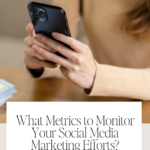
Is Your Social Media Marketing Efforts Paying Off? Metrics to Measure
Table of Contents
ToggleSharing is caring!
Reading Time: 5 minutes


Social media is a powerful tool for businesses to connect with customers and promote their products or services. But simply posting content on social platforms is not enough. It’s vital to evaluate whether your marketing efforts are getting the results you need to spread the word about your business.
Knowing the impact of your social media marketing helps you understand if you're reaching your target audience effectively. By analyzing metrics such as engagement, reach, and impressions, you can determine if your content is resonating with your intended audience or if adjustments are needed.
The performance of your social media campaign will affect your bottom line too. If your social media marketing efforts are paying off, you’re bound to pour in more funds to achieve greater heights. You can identify which platforms and campaigns are generating the most value for your business and adjust your strategy accordingly.
By understanding what content performs well and what doesn't, you can adapt your approach to stay relevant and competitive in the ever-changing social landscape.

What Metrics to Monitor Your Social Media Marketing Efforts?
To know if your social media efforts are working well, you need to keep an eye on specific metrics. These metrics include:
- Reach
- Share of Voice
- Conversion Metrics
- Engagement Metrics
Monitoring these metrics will help you discover how many people are seeing your content, engaging with it, and whether your audience is growing. By keeping track of these metrics, you can gauge the effectiveness of your social media efforts.
Reach
Reach tells you how many individuals have come across your social media posts. It's like counting the number of people who glanced at your billboard on the street.
Factors that cover reach include:
- Unique Views
- Impressions
- Follower Count
- Audience Growth Rate
Unique views: Unique views show how many different people saw your content – both organically or through re-shares, not just how many times it was seen overall.
Impressions: This measures how many viewers interacted with your content – like hitting the like or reshare button.
Follower count: simply the number of people who have subscribed to see your updates. A higher follower count usually means your message has a better chance of reaching more people.
Audience Growth Rate: This metric measures how fast your follower count is increasing over time. It's like watching a tree grow. You want to see steady growth because it means more people are interested in what you're sharing.
If your reach and impressions are high, your follower count is growing, and your audience growth rate is steady, then your efforts are likely paying off. But if these numbers aren't where you want them to be, it might be time to adjust your strategy.
Share of Voice
This metric helps you see how much of the conversation surrounding your industry or niche your brand owns compared to your competitors. It tracks the number of people mentioning or tagging your account compared to the competition.
Imagine your industry is a big pie, and each slice represents a different brand. Your goal is to have the biggest slice, showing that more people are talking about and engaging with your brand compared to others.
Identify the keywords, hashtags, or topics relevant to your industry or niche. These could be terms related to your products, services, or broader industry trends. Then, track the mentions and tags across all social media platforms.
Add up all the mentions of your brand across social media platforms and divide it by the total number of mentions for all brands in your industry space. Multiply the result by 100 to get a percentage. This percentage represents your brand's Share of Voice.
Now compare your Share of Voice with that of your competitors. Are you dominating the conversation? Understanding where you stand relative to competitors can help you set realistic goals and adjust your social media strategy accordingly.
Conversion Metrics
Conversion metrics help you understand how effectively your social media activities are driving valuable actions, such as website visits, sign-ups, purchases, or other desired outcomes. These metrics include:
- Website Referrals
- Social Media Conversions
- Conversion Rate
- Click-Through-Rate (CTR)
- Bounce Rate
Website Referrals: Website referrals refer to the number of visitors who land on your website from social media platforms. By tracking website referrals from social media, you can figure out how successful your social media efforts are in driving traffic to your website.
Social Media Conversions: Social media conversions measure the number of desired actions taken by users after interacting with your social media content. These actions could include:
- Signing up for a newsletter
- Downloading a resource
- Making a purchase
- Filling out a contact form.
Tracking social media conversions helps you understand the direct impact of your social media efforts on achieving your business goals.
Conversion Rate: Conversion rate is the percentage of website visitors who complete a desired action, such as making a purchase or filling out a form, after clicking on a social media link. A higher conversion rate indicates that your social media content is effectively persuading users to take action, while a lower conversion rate may signal the need to optimize your content or user experience.
Click-Through-Rate (CTR): Click-through-rate measures the percentage of people who click on a link in your social media post or ad compared to the total number of people who saw the post or ad. A higher CTR indicates that your content is engaging and compelling enough to attract clicks, while a lower CTR may indicate the need for adjustments to your messaging or visuals.
Bounce Rate: Bounce rate measures the percentage of visitors who navigate away from your website after viewing only one page without interacting further or exploring other pages. A high bounce rate could indicate that your social media traffic is not finding what they expected or that your website experience needs improvement.
Engagement Metrics
These metrics indicate how actively your audience is interacting with your content and can provide valuable insights into the effectiveness of your social media strategy. The engagement metrics cover:
- Likes
- Comments
- Shares
- Clicks
- Applause Rate
Likes: Likes represent the number of times users have indicated that they enjoyed or appreciated your social media post by clicking the “like” button. Tracking likes helps you understand the level of positive sentiment and affinity towards your content.
Comments: Comments refer to the number of responses or feedback left by users on your social media posts. These could include questions, opinions, or discussions related to the content. Monitoring comments allows you to gauge how well your content resonates with your audience and provides opportunities for engagement and interaction.
Shares: Shares indicate the number of times users have shared your social media content with their own networks. Tracking shares helps you measure the virality and reach of your content, as well as identify potential brand advocates who are actively promoting your message to a wider audience.
Clicks: Clicks measure the number of times users have clicked on links or call-to-action buttons within your social media posts. It's similar to someone following directions or taking action based on your recommendation.
Applause Rate: The applause rate, also known as the engagement rate, calculates the overall level of engagement on your social media posts relative to the number of followers or impressions. A higher applause rate indicates stronger engagement and interaction with your content, while a lower rate may suggest the need for adjustments to your content strategy.
Measuring the performance of your social media marketing campaign is critical to the growth of your business. If you're not tracking the metrics, you might miss opportunities to learn from your followers and improve your campaign for a higher chance of success.
Most Popular Posts:
Sharing is caring!
PLEASE COMMENT BELOW